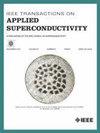Solder-Free Low Resistive Joining of Metal Stabilization Layers of REBCO Coated Conductors by Use of Sonic-Welding Technique
IF 1.7
3区 物理与天体物理
Q3 ENGINEERING, ELECTRICAL & ELECTRONIC
引用次数: 0
Abstract
We have developed a solder-free sonic welding technique for joining coated conductor tapes using only sonic energy. This method eliminates the need for surface treatments such as oxide film removal and avoids the use of intermediate metals like solder or indium foil. In this study, a joint resistivity of 17.3 nΩcm2 at 77 K, less than half that of typical solder joints, was achieved with solder-free sonic-welding process by using appropriate welding parameters and 15 kHz sonic vibration. Scanning Hall-probe microscopy (SHPM), which enables 2-D visualization of the critical current density (求助全文
约1分钟内获得全文
求助全文
来源期刊

IEEE Transactions on Applied Superconductivity
工程技术-工程:电子与电气
CiteScore
3.50
自引率
33.30%
发文量
650
审稿时长
2.3 months
期刊介绍:
IEEE Transactions on Applied Superconductivity (TAS) contains articles on the applications of superconductivity and other relevant technology. Electronic applications include analog and digital circuits employing thin films and active devices such as Josephson junctions. Large scale applications include magnets for power applications such as motors and generators, for magnetic resonance, for accelerators, and cable applications such as power transmission.
 求助内容:
求助内容: 应助结果提醒方式:
应助结果提醒方式:


